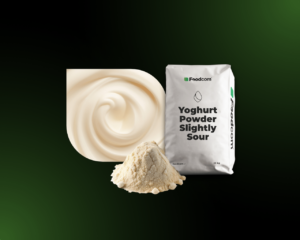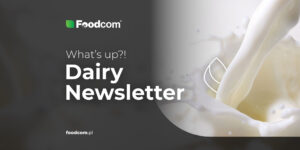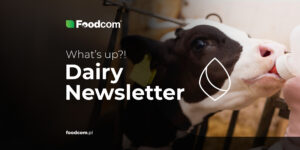- Prices of SMP, cheese, and butter in Europe remain stable despite seasonal increases in milk production.
- Demand from Asia is pushing up prices for whey and lactose, with weak exports from the US.
- The crisis in Australia and foot-and-mouth disease in Hungary may affect global supply chains.
- UHT milk is gaining importance thanks to innovations and health trends.
Welcome Partners!
Welcome back to our newsletter!
The European dairy market remains stable. SMP, cheese and butter prices remain stable despite seasonal peaks in milk production. Liquid products are slightly cheaper, while whey is gaining in value thanks to demand from Asia. Global events, from Australia to Hungary, add complexity to the market. What impact will they have in the coming months?
Let’s take a look at what has been happening in the dairy market recently!
Milk powder
The European market for skimmed milk powder (SMP) remains stable, with prices fluctuating between 2300-2400 EUR/MT EXW, depending on quality and freshness. Increased availability of raw milk during the peak season has put some pressure on milk concentrate prices. However, low SMP stock levels and expectations of an increase in demand after Q2 support a moderately optimistic mood.
In the feed SMP market, prices fell slightly, reaching around 2450 EUR/MT DAP NL in Q2 and Q3. The small difference between buying and selling prices reflects the continued caution of market participants in the face of limited export activity and currency pressure.
Meanwhile, Algeria’s state agency O.N.I.L. has launched a new tender for dairy products, seeking SMP and WMP supplies between July and October. Interested parties must submit their bids by Wednesday. The results of the tender are likely to be announced next week and it remains to be seen how they will affect the price dynamics of SMP and WMP in the coming months.
Cheese
The cheese market in Europe remains relatively stable. Gouda cheese prices remain at 4250-4350 EUR/MT and edam cheese prices are around 4200-4300 EUR/MT.
Demand remains moderate, with both buyers and producers approaching the market cautiously as milk production continues to increase seasonally. The limited availability of cheese is preventing sharp price falls, although future developments will depend on how milk volumes develop in Europe. Cagliata and cheddar cheese prices have also remained stable.
Fats
Butter prices in Europe remain stable at 7150 to 7300 EUR/MT EXW for standard blocks, with small packs reaching prices as high as 7450 EUR/MT.
High cream prices and limited market activity provide solid support for current butter price levels. In the US, butter markets remain under pressure due to the high availability of milkfat, while Oceania saw a price increase towards the end of the dairy season. Anhydrous milk fat (AMF) prices have also remained stable over the past week.
Liquids
Cream prices in Europe are stable or slightly lower after the Easter holidays and currently stand at 8300-8400 EUR/MT. Limited changes suggest continued caution across the liquid dairy sector.
SMC prices in Germany have fallen to 1680-1800 EUR/MT FCA, driven by increasing milk supply and weak demand from the powder sector.
Milk spot prices in the Netherlands, Germany and France fell significantly, confirming the seasonal peak in milk production across Europe.
Whey powder
The European sweet whey powder market is seeing an increase in demand from China, leading to a slight increase in prices. Prices for SWP destined for consumption remain around 1075 EUR/MT, while prices for SWP destined for feed production are 910-920 EUR/MT.
Meanwhile, the US whey market remains under pressure due to reduced exports to China, forcing sellers to look for alternative markets. As a result, whey prices in Europe should remain stable, while prices in the US will continue to be under downward pressure.
Lactose prices in Europe are rising rapidly, currently reaching around 1,250 EUR/MT, driven by increased demand from Asia following the imposition of tariffs on the US product. Meanwhile, prices in the US remain much lower, at 730-740 EUR/MT.
Whey protein isolate(WPI) is seeing a slight downward correction in both major regions. In Europe, the price has fallen to around 21200 EUR/MT, while in the US it is now around 17800 EUR/MT. Although fundamentals remain relatively solid, increased raw material availability and weaker exports are putting downward pressure on prices further.
The value of WPC80 in Europe is stabilising at around 12,000 EUR/MT, but in the US there has been a significant price drop to near 9,000 EUR/MT. The loss of the Chinese market to US exporters is forcing them to take more aggressive pricing action, which is also gradually affecting trading conditions in Europe.
What’s new?
Australia
Australian dairy farmers have found themselves in a difficult situation following the collapse of Beston Global Food Company in February 2025. As a result of the bankruptcy, around 40 South Australian farmers were left with unpaid invoices totalling more than 10 million Australian dollars, and around 150 people lost their jobs. The effects of the COVID-19 pandemic and rising interest rates contributed to the company’s liquidation. In response to the crisis, the South Australian government has allocated 3 million Australian dollars to a relief fund. It is administered by the South Australian Dairy Cattle Breeders Association (SADA) and the South Australian Finance Agency (SAFA). The fund aims to support affected farmers by enabling them to invest and rebuild their farms. Funds awarded must not exceed the amount of losses incurred and must be used in accordance with an approved development plan.
Europe
A fifth case of FMD in cattle has been reported in Hungary, this time on a farm in Rábapordány, located about 30 kilometres south of previous outbreaks near the border with Slovakia. In a herd of 600 cows, the disease was diagnosed on 17 April, after symptoms were observed in one cow during morning milking. The authorities confirmed the infection and ordered the culling of the entire herd to stop the spread of the virus. Previous outbreaks have occurred in the north-western regions of the country and in Slovakia, prompting neighbouring countries such as Austria and the Czech Republic to introduce preventive measures, including the closure of some border crossings and the disinfection of vehicles. Hungarian services are taking measures to contain the outbreak, such as disinfecting farms and providing financial support to affected farmers.
Europe
UHT milk, prized for its long shelf life and convenience of storage, is today becoming a field of innovation in response to growing consumer expectations for health and sustainability. Manufacturers such as Tetra Pak are introducing new solutions, such as enriching milk with vitamin D and zinc to support immunity or adding chamomile to improve sleep quality. OneStep technology makes the UHT milk production process more efficient, combining several steps into one, reducing production time and energy consumption. Innovative aseptic packaging, often made from renewable materials, not only extends the shelf life of the product, but also responds to the needs of consumers looking for greener solutions. The changes being introduced open up new opportunities for the UHT milk market, making it more attractive to conscious consumers.
![European dairy market update – stabilisation despite seasonal changes [265th Edition of DAIRY Newsletter] European dairy market update – stabilisation despite seasonal changes [265th Edition of DAIRY Newsletter]](https://foodcom.pl/wp-content/uploads/2024/05/Foodcom_SA_Dairy_Newsletter_1-1520x760.jpg)






